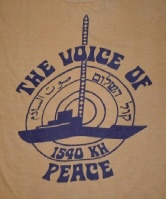© 2014-


Voice of Peace - History (9)
1987
In early May 1987 a new medium wave transmitter was installed on the MV Peace in Ashdod and the aerial mast, which had been damaged during the previous winter, was repaired. At the same time the FM transmitter power was returned to 20kW output after new spare parts had been delivered to the ship.
The Peace left port in the early morning of 14th May 1987 and Voice of Peace test transmissions on FM started that evening . Unfortunately problems were being encountered with the new medium wave transmitter which would not feed its signal into the aerial system properly and a new tuning unit had to be ordered from America. This was eventually delivered on 5th June 1987 and an engineer from the transmitter's manufacturers, Nautel, went out to the ship to install it and make sure everything was working properly.
Tests on medium wave then started during the evening of 9th June 1987 and the full medium wave service began again the following evening. A split frequency service was briefly re-
By the end of June 1987 both FM and AM transmitters were running at full power, but the station suffered problems with staff shortages throughout the summer. In general the Voice of Peace seemed to have lost its sense of purpose and lacked any real direction by mid-
In September 1987, following a visit by Abie Nathan to London to recruit more staff and stock up on CDs and records, yet another new format was introduced on the Voice of Peace, with the slogan (and jingle package) "latest hits, greatest memories". This revised, livelier programming resulted in a renewed interest from advertisers and quite soon the station was broadcasting up to 10 different commercials each hour.
In early October 1987 the Government state network, Kol Israel, was closed by a strike. The Voice of Peace normally relayed Kol Israel's hourly news bulletins , so attempts had to be made to provide an alternative service using the signal from the BBC's World Service transmitter in Cyprus. However, it proved impossible to obtain a signal of satisfactory quality which could be re-
However, following pressure on Abie Nathan from the Kol Israel journalists' trade union the on-
One positive side effect of the Kol Israel strike for the Voice of Peace was that the station was able to substantially increase its advertising revenue. Being the only commercial radio station broadcasting at the time advertisers vied with each other to purchase airtime and at one stage the Voice of Peace was transmitting up to 26 spots per hour. This increased income enabled Abie Nathan to purchase and install a fax machine and radar system on board the MV Peace and consideration was also given to the purchase of new FM and shortwave transmitters.
The strike at Kol Israel was settled early in December 1987, and almost immediately this resulted in an end to the Voice of Peace's advertising bonanza. Transmitter problems were encountered later in the month when the offshore station was put off the air on medium wave from 21st-
1988
The same problem occurred again at the end of January 1988 and although the new FM transmitter stayed on the air during these periods it also suffered frequent short breaks in transmission. The Voice of Peace's brief domination of the Israel radio market seemed to have come to an end.
The MV Peace was damaged while in port at the end of January 1988 -
The Voice of Peace's format at this time still included a Russian hour and programmes of Greek or Arabic music. In addition Abie Nathan used the Voice of Peace to broadcast his own views and opinions on a wide variety of subjects and frequently came on air to talk about some issue which was important to him at the time. These factors led to growing numbers of the station's audience re-
There was little or no official publicity material produced for the station - shops the only other publicity came from a contra-
shops the only other publicity came from a contra-
No conventional research was undertaken to determine the station's listening figures or audience profile, but from letters received by DJs at the time it was possible to crudely gauge the size of the Voice of Peace's potential audience. During the day the station appeared to be popular with girls between the ages of 15/17, while older people listened during the evenings -
The concept of peace promotion returned at the beginning of 1988 after Abie Nathan apparently realised that the Voice of Peace seemed to be lacking any purposeful direction. He declared 26th February 1988 to be a Peace Day and to mark the visit to Israel of US Secretary of State George Schultz the Voice of Peace played only peace music in all its programmes.


Click on picture to enlarge
History
Key Dates
Ship and Location
Technical
Staff
Programmes






Treasure Chest


Back to Voice of Peace

Back to Israel Gallery


VOP T-